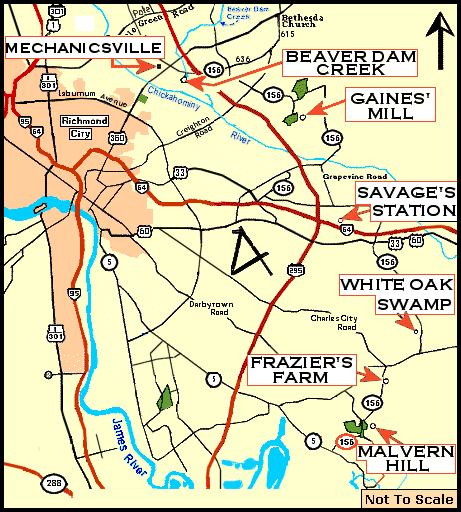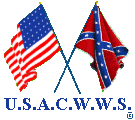
|
U. S. CIVIL WAR
PHOTOGRAPHS
|

|
REPORTS OF GENERAL ROBERT E. LEE
(PAGE 1 OF 5)
(On the battles of Mechanicsville, Gaines' Mill, Savage Station, the engagement
at White Oak Swamp Bridge, and the battles of Frazier's Farm and Malvern Hill,
with orders.)
|
Source: O.R.-- Series I--Volume XI/2 (With Editing - Ed)

Current Map of the Area addressed in these reports.
| |
HEADQUARTERS ARMY OF NORTHERN VIRGINIA,
March 6, 1863.
SIR:
After the battle of Seven Pines the Federal Army, under General McClellan,
preparatory to an advance upon Richmond, proceeded to fortify its position on the
Chickahominy and to perfect the communications with its base of supplies near
the head of York River. Its left was established south of the Chickahominy, between
White Oak Swamp and New Bridge, defended by a line of strong works, access to
which, except by a few narrow roads, was obstructed by felling the dense forests
in front. These roads were commanded for a great distance by the heavy guns in
the fortifications. The right wing lay north of the Chickahominy, extending
beyond Mechanicsville, and the approaches from the south side were strongly
defended by intrenchments. Our army was around Richmond, the divisions of Huger
and Magruder, supported by those of Longstreet and D. H. Hill, in front of the
enemy's left, and that of A. P. Hill extending from Magruder's left beyond Meadow
Bridge.
The command of General Jackson, including Ewell's division, operating in the
Shenandoah Valley, had succeeded in diverting the army of McDowell at
Fredericksburg from uniting with that of McClellan. To render this diversion
more decided, and effectually mask his withdrawal from the valley at the proper
time, Jackson, after the defeat of Frémont and Shields, was re-enforced by
Whiting's division, composed of Hood's Texas brigade and his own, under Colonel
Law, from Richmond, and that of Lawton, from the south.
The intention of the enemy seemed to be to attack Richmond by regular approaches.
The strength of his left wing rendered a direct assault injudicious, if not
impracticable. It was therefore determined to construct defensive lines, so as
to enable a part of the army to defend the city and leave the other part free to
cross the Chickahominy and operate on the north bank. By sweeping down the river
on that side and threatening his communications with York River it was thought
that the enemy would be compelled to retreat or give battle out of his
intrenchments. The plan was submitted to His Excellency the President, who was
repeatedly on the field in the course of its execution.
While preparations were in progress a cavalry expedition, under General Stuart,
was made around the rear of the Federal Army to ascertain its position and
movements [See Stuart's Ride
-Ed.]. This was executed with great address and daring by that accomplished officer.
As soon as the defensive works were sufficiently advanced General Jackson was
directed to move rapidly and secretly from the valley, so as to arrive in the
vicinity of Ashland by June 24.
The enemy appeared to be unaware of our purpose, and on the 25th attacked
General Huger on the Williamsburg road, with the intention, as appeared by a
dispatch from General McClellan, of securing his advance toward Richmond. The
effort was successfully resisted and our line maintained.
BATTLE OF MECHANICSVILLE.
According to the general order of battle, a copy of which is annexed, General
Jackson was to march from Ashland on the 25th in the direction of Slash Church,
encamping for the night west of the Central Railroad, and to advance at 3 a.m.
on the 26th and turn Beaver Dam. A. P. Hill was to cross the Chickahominy at
Meadow Bridge when Jackson's advance beyond that point should be known and move
directly upon Mechanicsville. As soon as the Mechanicsville Bridge should be
uncovered Longstreet and D. H. Hill were to cross, the latter to proceed to the
support of Jackson and the former to that of A. P. Hill. The four commands were
directed to sweep down the north side of the Chickahominy toward the York River
Railroad, Jackson on the left and in advance, Longstreet nearest the river and
in the rear. Huger and Magruder were ordered to hold their positions against any
assault of the enemy, to observe his movements, and follow him closely should he
retreat. General Stuart, with the cavalry, was thrown out on Jackson's left to
guard his flank and give notice of the enemy's movements. Brigadier-General
Pendleton was directed to employ the Reserve Artillery, so as to resist any
approach of the enemy toward Richmond, to superintend that portion of it posted
to aid in the operations of the north bank, and hold the remainder ready for
use when it might be required.
In consequence of unavoidable delays the whole of General Jackson's command did
not arrive at Ashland in time to enable him to reach the point designated on
the 25th.
His march on the 26th was consequently longer than had been anticipated, and
his progress being also retarded by the enemy, A. P. Hill did not begin his
movement until 3 p.m., when he crossed the river and advanced upon Mechanicsville.
After a sharp conflict he drove the enemy from his intrenchments, and forced him
to take refuge in his works on the left bank of Beaver Dam, about 1 mile distant.
This position was a strong one, the banks of the creek in front being high and
almost perpendicular, and the approach to it over open fields, commanded by the
fire of artillery and infantry intrenched on the opposite side. The difficulty
of crossing the stream had been increased by felling the woods on its banks and
destroying the bridges.
Jackson being expected to pass Beaver Dam above and turn the enemy's right, a
direct attack was not made by General Hill. One of his regiments on the left of
his line crossed the creek to communicate with Jackson and remained until after
dark, when it was withdrawn. Longstreet and D. H. Hill crossed the Mechanicsville
Bridge as soon as it was uncovered and could be repaired, but it was late before
they reached the north bank of the Chickahominy. D. H. Hill's leading brigade,
under Ripley, advanced to the support of the troops engaged, and at a late hour
united with Pender's brigade, of A. P. Hill's division, in an effort to turn the
enemy's left; but the troops were unable in the growing darkness to overcome the
obstructions, and after sustaining a destructive fire of musketry and artillery
at short range were withdrawn. The fire was continued until about 9 p.m., when the
engagement ceased. Our troops retained the ground on the right bank, from which
the enemy had been driven.
Ripley was relieved at 3 a.m. on the 27th by two of Longstreet's brigades, which
were subsequently re-enforced. In expectation of Jackson's arrival on the enemy's
right the battle was renewed at dawn, and continued with animation for about two
hours, during which the passage of the creek was attempted and our troops forced
their way to its banks, where their progress was arrested by the nature of the
stream. They maintained their position while preparations were being made to cross
at another point nearer the Chickahominy. Before they were completed Jackson
crossed Beaver Dam above, and the enemy abandoned his intrenchments and retired
rapidly down the river, destroying a great deal of property, but leaving much
in his deserted camps.
|
|
|
PAGE 2
 >
Civil War Photos
>
Richmond - Outlying Area
>
Lee Reports
>
2
>
3
>
4
>
5
>
Civil War Photos
>
Richmond - Outlying Area
>
Lee Reports
>
2
>
3
>
4
>
5
Copyright 2011, 2012 by Content Team, all rights reserved.
|
|




